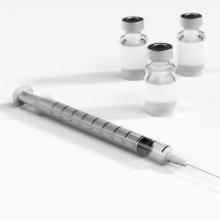Newsroom
The percent of smokers that consistently smoke less than 10 cigarettes per day - called social smoking, is increasing. In the US, about 1 in 4 smokers fall into this group. Although this is a step in the right direction, some people may incorrectly think that smoking less protects them from… more
Osteosarcoma is a kind of bone cancer. It affects mostly children and young adults and is a leading cause of cancer-related death in children. The disease is often treated with surgery to remove the tumor and chemotherapy before and after surgery. Due to bone… more
New research done by Dr. Henry Park and his colleagues at the Yale School of Medicine shows that oncologists have started prescribing less opioids for their patients. Researchers believe that this is in response to the national opioid epidemic. Considering that opioid prescriptions from oncologists… more
Google has been chosen to help the U.S. Defense Innovation Unit in designing an artificial intelligence (AI) model that could help study and identify cancers found in veterans. The AI will be used to create augmented-reality microscopes that can help doctors efficiently map out… more
A team of researchers from Duke University, Case Western Reserve Medical School, and the Cleveland clinic lead by Efstathios Karathanasis, an associate professor of biomedical engineering, have developed a new treatment for breast cancer that combines immunotherapy (using one’s immune system to… more
Little is known about the causes of ovarian carcinoma, a major type of cancer affecting women. Fortunately, scientists at the College of Veterinary Medicine have performed a study that attempts to identify the effects of specific genetic changes (mutations) on the development of the disease.… more
>Hyperthemic Intraperitoneal Chemotherapy (HIPEC), a treatment for appendix and colon cancer that involves heating chemotherapy and delivering it to the abdominal cavities, can be paired with surgery to greatly increase life expectancy for patients. Heated chemotherapy is typically used to treat… more
Results from a new study show that some older adults are being over screened for cancer. They are being screened when the test is not likely to provide an overall benefit. The United States Preventive Services Task Force (USPSTF) recommends that people get screened for cancer through ages 65-75 for… more
Immunotherapy, the use of one’s own immune system to fight disease, is a common treatment for cancers. In one form or another, immunotherapy has been involved in the fight against cancer for many years. One of the first immunotherapies is called Coley toxin, named after the scientist who discovered… more
Scientists at Johns Hopkins and the University of Oxford are researching new ways to selectively kill breast cancer cells. In their effort to find targets that would allow cancer cells to be killed and spare normal cells, the researchers focused in on a small cell structure called a centrosome.… more
Small cell lung cancer (SCLC) is an aggressive form of lung cancer which is often not detected until after the disease starts to spread (metastasize). Although chemotherapy can be effective at first, the disease often becomes resistant to the treatment. Because of this, there is a need for new… more
Researchers at the University of Southern California have discovered how to use common dyes such as tattoo ink and food coloring to improve the detection of cancer. When attached to tiny bead-like objects, the dyes move through the blood and collect in tumors. They can ‘light… more
Human papillomavirus (HPV), a common sexually transmitted virus, and the cause of cervical cancer, is being investigated for its possible role in prostate cancer. James Lawson and Wendy Glenn at the University of New South Wales reviewed existing studies linking HPV to prostate cancer. This is… more
It may seem strange that honeybee venom could be used to treat breast cancer, but it is currently being explored by Dr. Ciara Duffy at the Harry Perkins Institute of Medical Research and The University of Western Australia. She found that the venom itself, or melittin (a major venom… more
STING (Stimulator of Interferon Genes) is a protein involved in the immune response against viruses and cancers. Because of this, scientists are interested in harnessing STING for cancer treatment. The chemicals that activate STING, however, are often unstable, making it hard to use STING to… more
A vaccine to treat cancer? It may seem unlikely, but recent results have shown that a single vaccine may be ale to combat many different kinds of cancer.
In order to fight cancer, the immune system must be first be aware that abnormal cells are present. Fortunately, many different… more
The deaths and severe symptoms caused by COVID-19 are, in part, due to a frenzy of activity that the viral infection causes in the immune system of patients. The virus triggers the release of large amounts of signaling proteins (cytokines) - called a 'cytokine storm'. The storm leads to… more
The COVID epidemic has impacted cancer patients in many ways.
A recent issue of Cancerworld featured several informative articles about how the epidemic has changed cancer treatment and altered patients' lives. The link below leads to one article, but there are others in the May-June issue.
#… more
Before - during - and after cancer treatment. Exercise seems to help!
Research on high-risk breast cancer patients showed that those who exercised at moderate or vigorous levels had better survival than those who didn't. The cancer in patients who exercised was less likely to come back (recur) and… more
After heart disease, cancer is the second leading cause of death in the United States. The good news is that in the past 20 years, death rates for many cancers have decreased every year. For many cancers, this is due, in part, to improved treatments and better detection of early stage cancers… more




















